Original source: MegaETH
Handling a sale event that was oversubscribed by 28 times and had over 53,000 participants is not as easy as it sounds. In my previous article, I mentioned that our sale primarily focused on two groups:
· Those who were early active members of the MegaETH community
· Those we believe will accompany MegaETH for the long term
A few days before the sale ended, @artemis_onchain (our data lead) and I met in Istanbul to conduct extensive simulations. We tried many different methods to "perfectly" measure each person's contribution but quickly realized that it was impossible to do so in such a short time, as "contribution" is a multidimensional concept.
So we decided to break the problem down into two parts:
· Fairly allocate to existing community members
· Establish a data-driven scoring and allocation system for long-term investors
The following sections of this article will detail how we accomplished these two goals and the results we ultimately achieved.

Allocation for Existing Community Members
For the first allocation pool—our existing community—we adopted the most traditional method: manual allocation.
We relied on existing community infrastructure, including @Heisenbruh and our moderator network, to compile a list of members who have been continuously engaged since MegaETH came out of stealth mode.
This list includes those who:
· Joined early and remained active
· Helped shape the project's atmosphere and values
· Continued to support us during bear markets and periods of silence
· Provided feedback, signals, and energy before there were tokens to speculate on
It should be noted that most of these individuals did not choose to lock up their tokens. We believe this is perfectly fine. Their contributions have already been rewarded through time, attention, and trust. In our view, they have "put in the effort."
In the spirit of transparency, we hereby publish the list of sales participants that we believe represent the core community over the past few years.

We know this list cannot be perfect, and some people are certainly missing. If you are one of them, I sincerely apologize.

Aside from this group of community members and the application developers who chose to lock up for a year, others were not personally selected by the team.
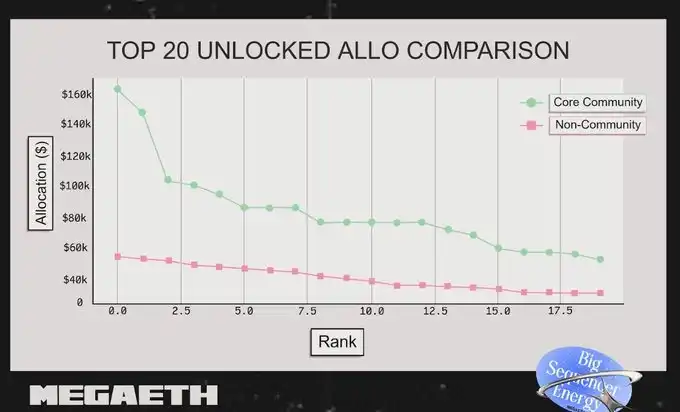
Even among this group selected by the team, not everyone received the full allocation, and the differences are quite significant.
Due to the scale of the sale and market demand, we had to make some trade-offs. However, we believe this approach respects those who have supported us all along while avoiding turning the entire sale into a pure "popularity contest."
Compared to algorithmic automatic allocations, these users generally received higher allocations. Aside from the application developers mentioned earlier, most participants' shares are not locked.
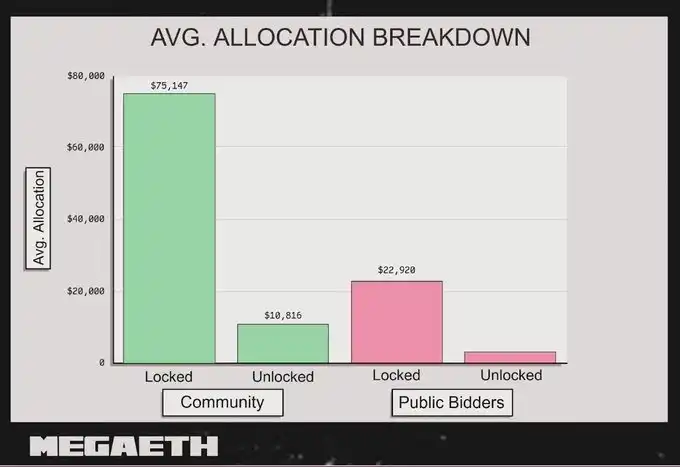
Measuring Long-term Investors
The second allocation pool targets users who participated in the sale through an open process and those who may become long-term holders of MegaETH.
In this part, we wanted to adopt a more systematic approach. We designed a scoring mechanism that takes into account the following dimensions:
· On-chain activity
· Social signals and natural exposure
· Specific interactions with MegaETH
· Whether they view participation as a long-term investment (e.g., willing to lock up for a year)
Our goal is not to reward "score farmers," but to identify participants who genuinely believe in the project.
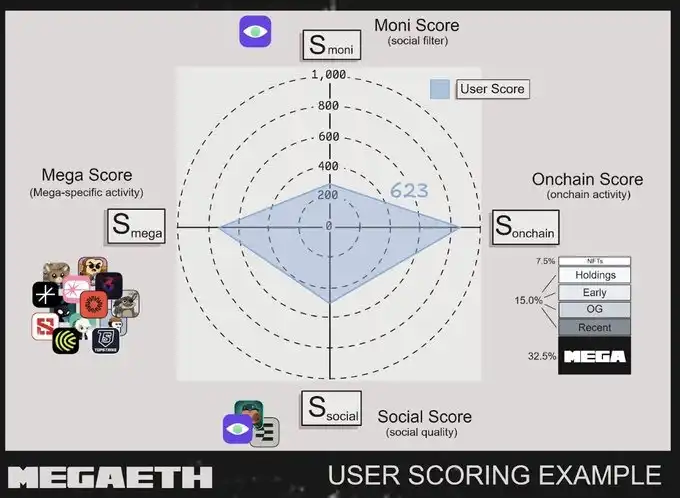
Evaluation Metrics
We used four different metrics in the overall scoring system:
1. Moni Score
The Moni score is used as:
· A basic screening criterion
· A component of the social score
For example:
· My Moni score is about 7,000
· @artemis_onchain's Moni score is about 300
Based on this distribution, we believe setting the Moni score at 50 is a reasonable minimum threshold in most cases. It is not a perfect measure of user quality, but it remains a useful reference line for distinguishing completely inactive accounts from those with at least some level of activity.
We also discuss and apply alternatives for social verification later in the text.
2. On-chain Activity Score

The on-chain activity score consists of multiple dimensions, each with different weights. The overall design is as follows:
· Early Participation (15%): Represents the behavior of early adopters and those willing to take risks
· OG Credentials (15%): A record of long-term participation in the entire crypto ecosystem
· Asset Holdings (15%): A reference for financial investment and "real money" participation
· NFT Activity (7.5%): A reflection of current on-chain activity, especially through NFT participation
· Recent Activity (15%): Not just past participation, but a focus on recent on-chain behavior
· MegaETH Related Behavior (32.5%): Includes CAP scores, MEGA NFT holdings, and specific testnet behaviors directly related to MegaETH
3. Social Score
The social score integrates multiple dimensions:
· Moni Score
· Kaito Data
· Other reference information (such as [ ] and Ethos) for manual review
We did not rely on a single metric but instead used multiple tools in combination. This approach helped us effectively filter out obvious bots and low-quality spam accounts while better identifying participants who are genuinely integrated into the community.
4. Mega Score
The Mega Score is specifically for participation signals related to MegaETH, including:
· CAP scores
· MEGA NFT holdings
· Specific testnet behaviors
We used the Mega Score in two ways:
As part of the on-chain activity score
As a basis for certain screening thresholds to ensure that users genuinely participating in MegaETH are not pushed out of the allocation range by general on-chain behavior "farmers"
Why Locking Up is Important
We placed a high weight on whether to choose to lock up $MEGA for a year.
In our view, being willing to lock up for a year in a highly volatile market is a strong expression of belief. No one can predict what will happen tomorrow, and choosing to lock up for a year expresses: "I am not here to trade short-term; I am here to participate long-term."
Participant Screening and Allocation Process
After completing the scoring, we still needed to decide on two things:
Who can enter the allocation list
How to convert scores into actual allocation amounts
We divided the process into two categories:
· Locked participants
· Non-locked participants
Screening Method for Locked Participants

For users who choose to lock up, they must meet at least one of the following conditions to be considered:
· Moni score above 50
· On-chain score above 200
· Mega Score shows holding more than one Fluffle NFT
In other words, you need to meet at least one of the following:
· Basic social activity
· Clear on-chain behavior signals
· Strong MegaETH participation record
After applying these screening criteria, about 29.4% of locked addresses made it to the allocation list, approximately 1,000 addresses.
Once a wallet passes the screening, its allocation amount will be determined based on the final score, which integrates on-chain and social signals. We adopted a segmented continuous curve approach, ensuring a minimum allocation while providing higher rewards for high-scoring users.
The specific allocation logic is as follows:
· Top 5%: Linear decline, allocation ratio from 100% to 95%
· Next 3% (5%-8%): Rapid decline, from 95% to 55%
· Next 7% (8%-15%): Continuing decline, from 55% to 35%
· Remaining 85%: Exponential decrease, with a minimum allocation of 25%
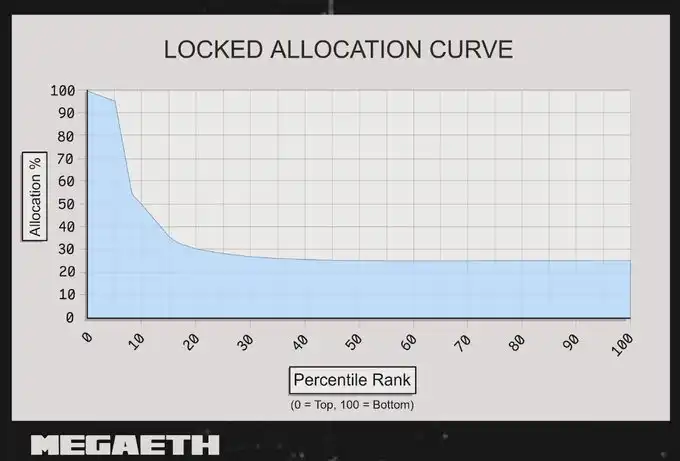
Screening Method for Non-locked Participants
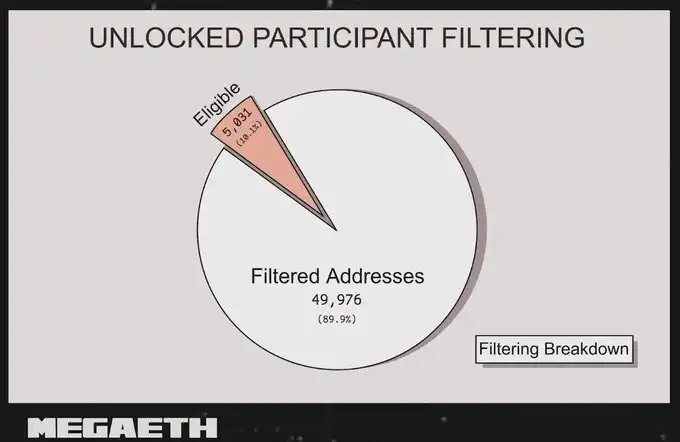
Non-locked addresses must meet at least one of the following conditions to enter the allocation list:
· Moni score > 200
· Social score > 200
· On-chain score > 300
· Mega Score > 68 (i.e., holding at least one Fluffle)
As long as you are active on-chain, have strong social signals, or have a clear participation record in MegaETH, you are eligible to participate without needing to meet all conditions simultaneously.
The actual screening results are as follows: Among 49,976 non-locked participants, a total of 5,031 wallets passed the screening, resulting in an acceptance rate of approximately 10.1%. Even for the minimum allocation amount, the competition is very fierce. We trust the algorithm's judgment and are clearly aware that even if some users have significant activity and holdings on MegaETH, they may still be excluded if other metrics are weak. However, this is a fair mechanism, and we respect the results.
In the list of those who passed the screening, we ranked the wallets based on their comprehensive scores and determined their allocation ratios accordingly.
The higher the ranking, the higher the allocation ratio; as the ranking decreases, the allocation ratio gradually decreases. After reaching a certain ranking, the curve flattens out, and the remaining users receive a uniform minimum allocation.

Small Bid and High Score Protection Mechanism
We noticed that some small bidders ranked similarly to large bidders. To ensure fairness, we established a mechanism: the actual allocation amount for any participant cannot be lower than that of the five adjacent addresses in the ranking.
For example, @thedefinvestor ranks in the top 15 among non-locked participants, but his bid is not high. Based on percentage allocation, he should have received a smaller amount. However, his neighbors are full bidders who received higher allocations.
To acknowledge @thedefinvestor's high ranking performance, we raised his allocation to be close to that of his neighbors. This is also part of the source for the 100% allocation ratio.
Case 1: Low Social Score, High On-chain Score
@cp0xdotcom has almost no presence on Twitter and has never tweeted about MegaETH, resulting in a very low social score. However, he still ranks in the top 20 among all participants and received 92% of his locked bid.
His advantages include:
· Over 8 years of on-chain history
· Consumed 194 ETH in gas
· Early participation in several contracts that later gained widespread adoption
· Interacted with 3,490 independent contracts
· Active on the mainnet for 164 out of the past 180 days
· No NFTs and no MegaETH-related behavior
His case illustrates that even without social or MegaETH backing, one can still achieve a high ranking with excellent on-chain performance.
Case 2: Low On-chain Score, High Social Score
@nics_off is almost the opposite of the above case. His wallet's on-chain history is less than two years, with only 1.5 ETH in gas consumption and interactions with about 150 contracts, resulting in a low on-chain score. However, his social score is outstanding:
· High activity on Twitter
· Ranked 13th in the Kaito MegaETH leaderboard
· Published a large amount of high-quality MegaETH content
These factors placed him 17th among non-locked participants, earning the highest allocation ratio in that group (20%).
His case also demonstrates that having a large number of followers is not enough; the social score is a weighted combination of Moni and Kaito, and the quality of MegaETH-related content is far more important than the number of followers.
We see many similar cases at the top of the leaderboard, particularly noteworthy are:
· @barthazian: Ranked first among all users, excelling in all metrics
· @0xMaxBT: Known as a MegaETH testnet legend, the only participant to complete all testnet contract interactions (the only one among 53,000 participants)
Sybil Attack Prevention Mechanism
We have implemented multi-layered Sybil protection measures:
Sybil cluster reports from the community and external teams (such as Bubble Maps and Echo) serve as direct screening criteria.
Our scoring system itself is also unfriendly to Sybil. To achieve a high score, a wallet must have genuine and credible on-chain behavior; low-quality associated addresses typically cannot pass.
We found that some wallets or social accounts are associated with multiple KYC bids; once such patterns are detected, all related requests will be invalidated.
For wallets that have already received allocations, we will continue to conduct Sybil checks, and if malicious behavior is discovered, we reserve the right to refund.
This article is from a submission and does not represent the views of BlockBeats.
免责声明:本文章仅代表作者个人观点,不代表本平台的立场和观点。本文章仅供信息分享,不构成对任何人的任何投资建议。用户与作者之间的任何争议,与本平台无关。如网页中刊载的文章或图片涉及侵权,请提供相关的权利证明和身份证明发送邮件到support@aicoin.com,本平台相关工作人员将会进行核查。




